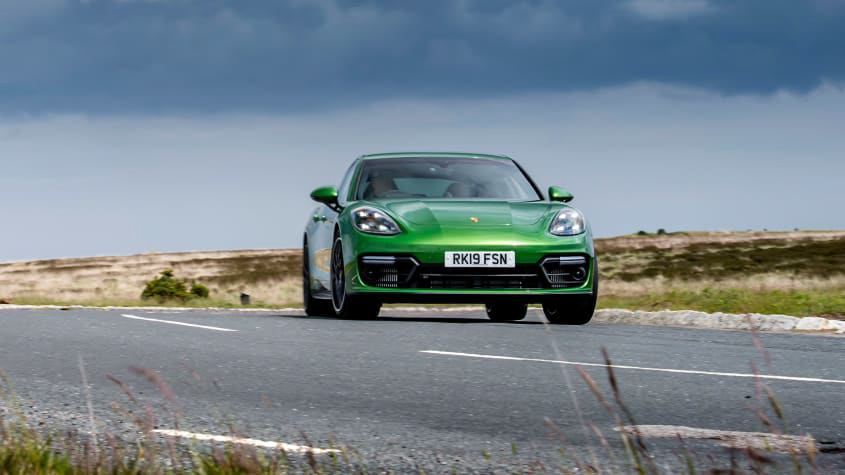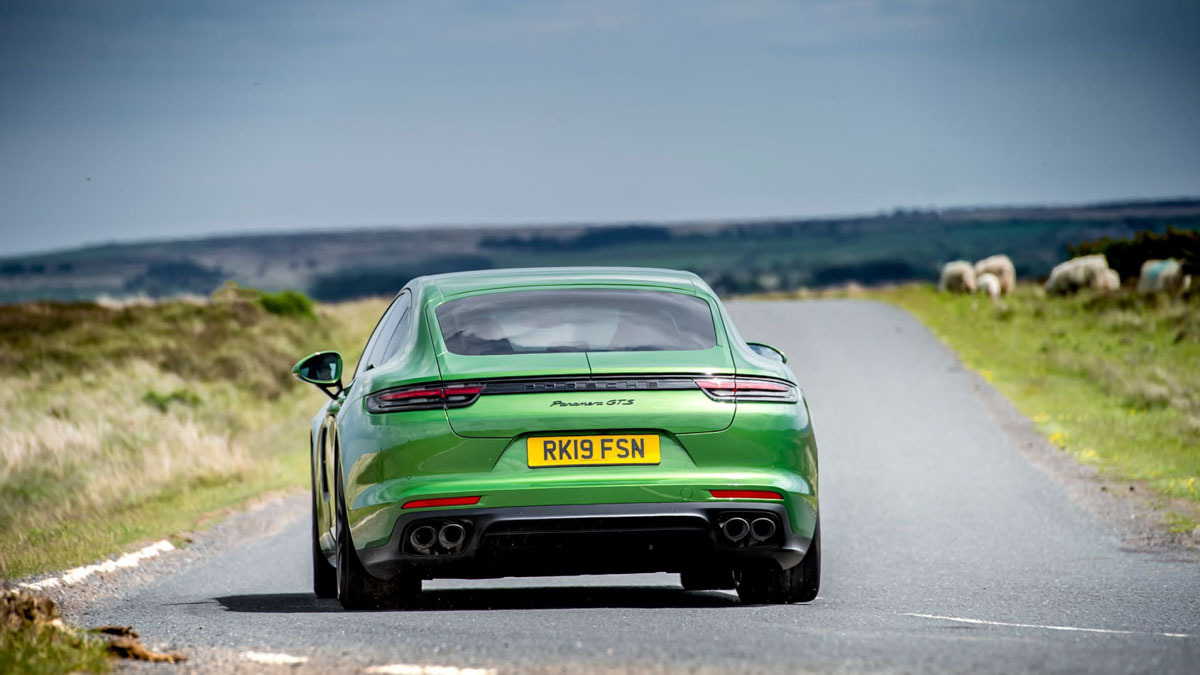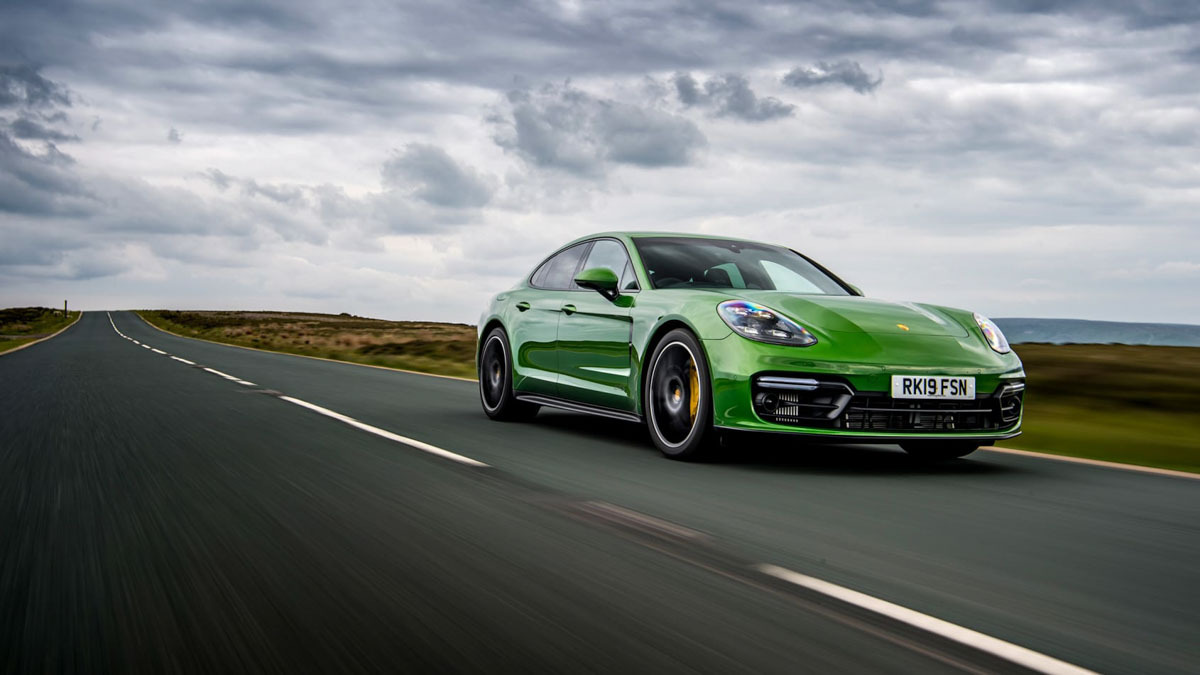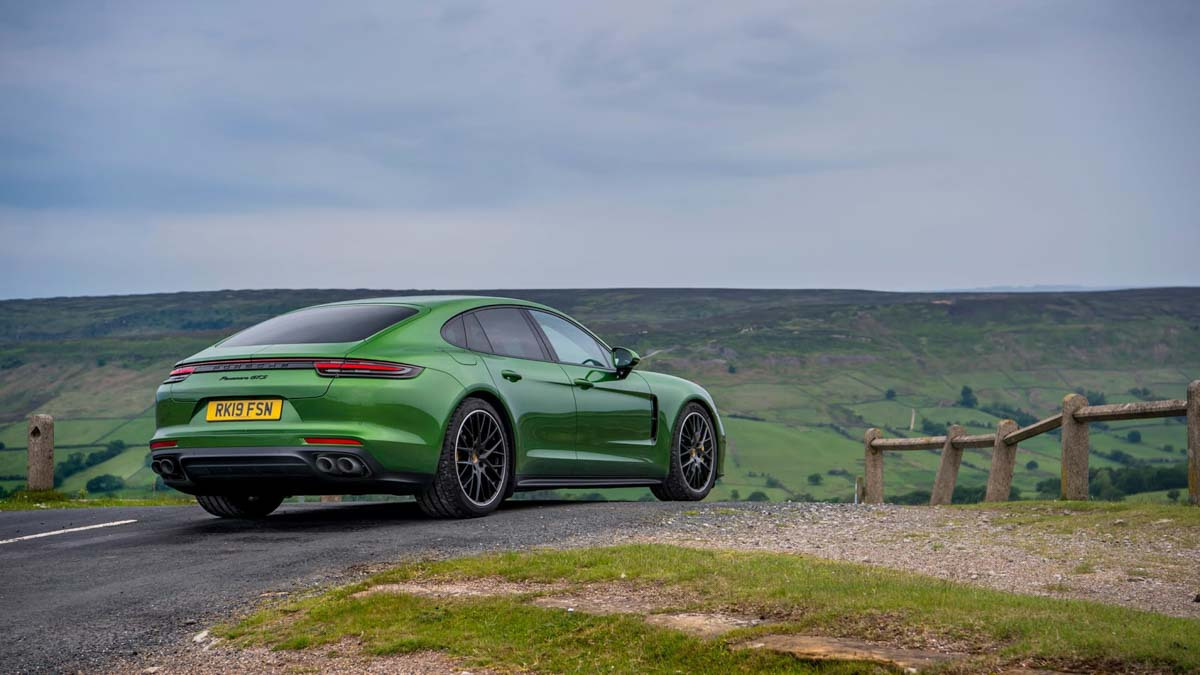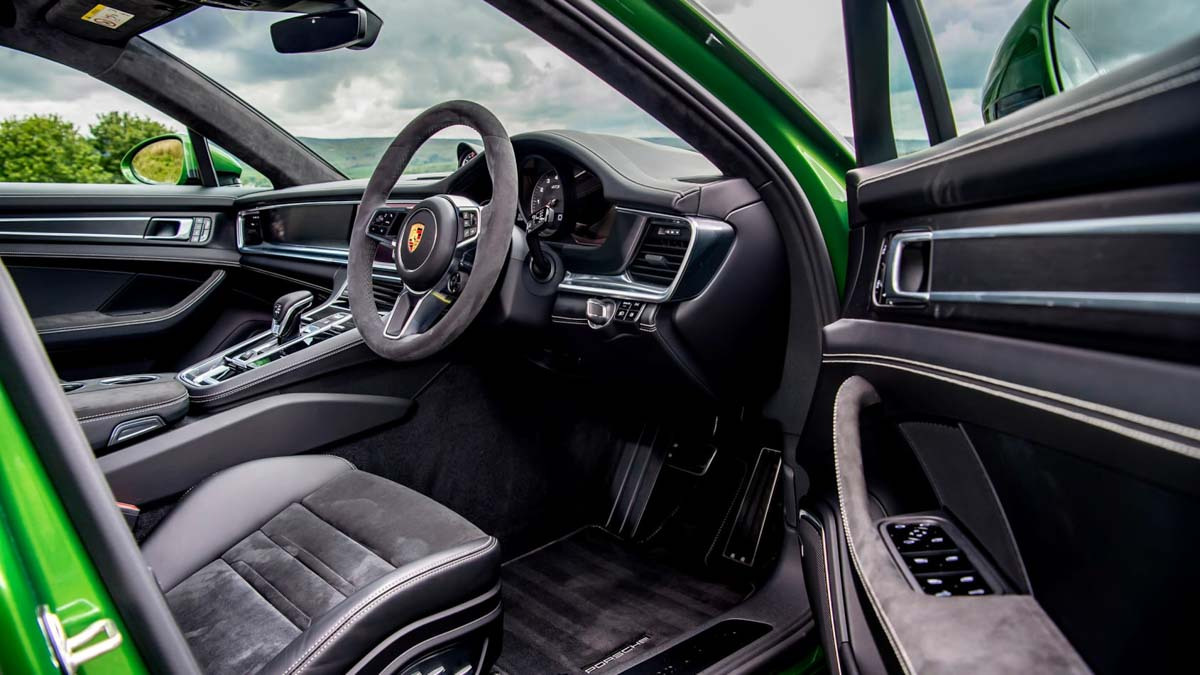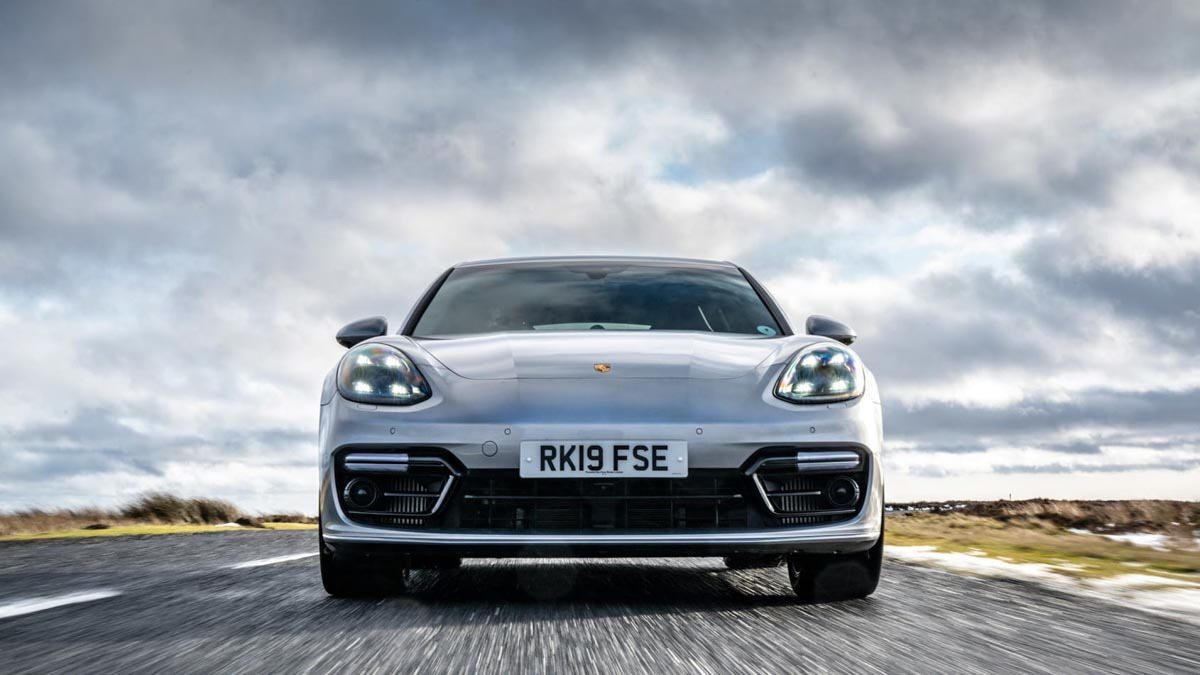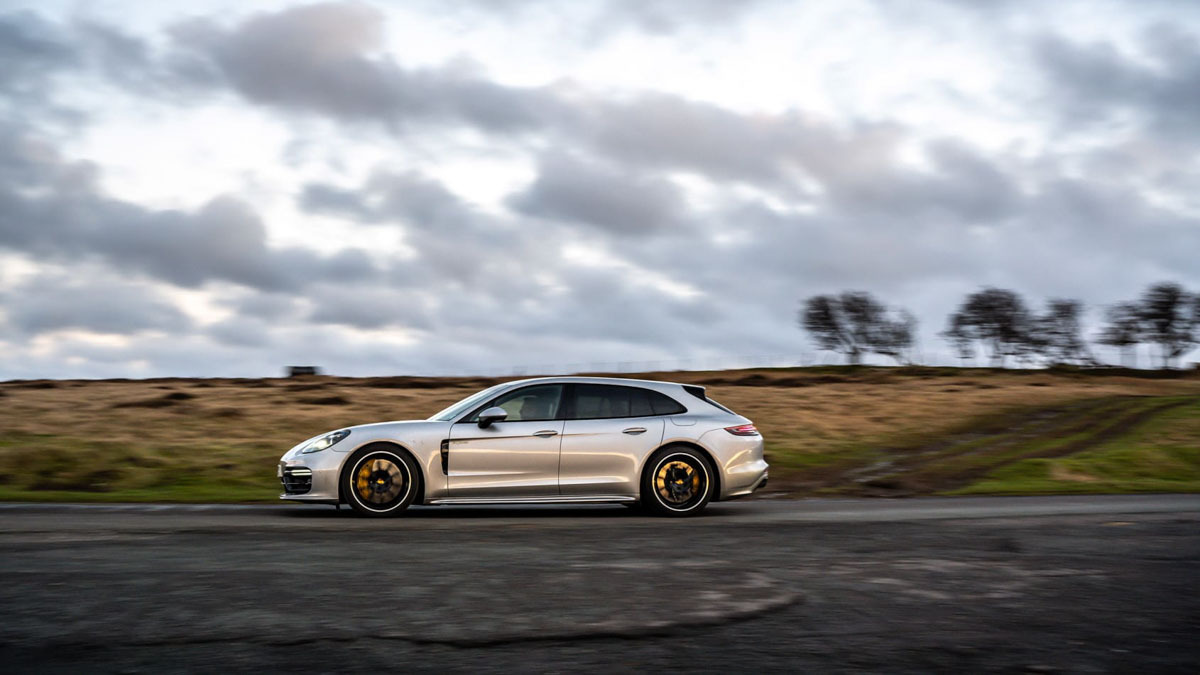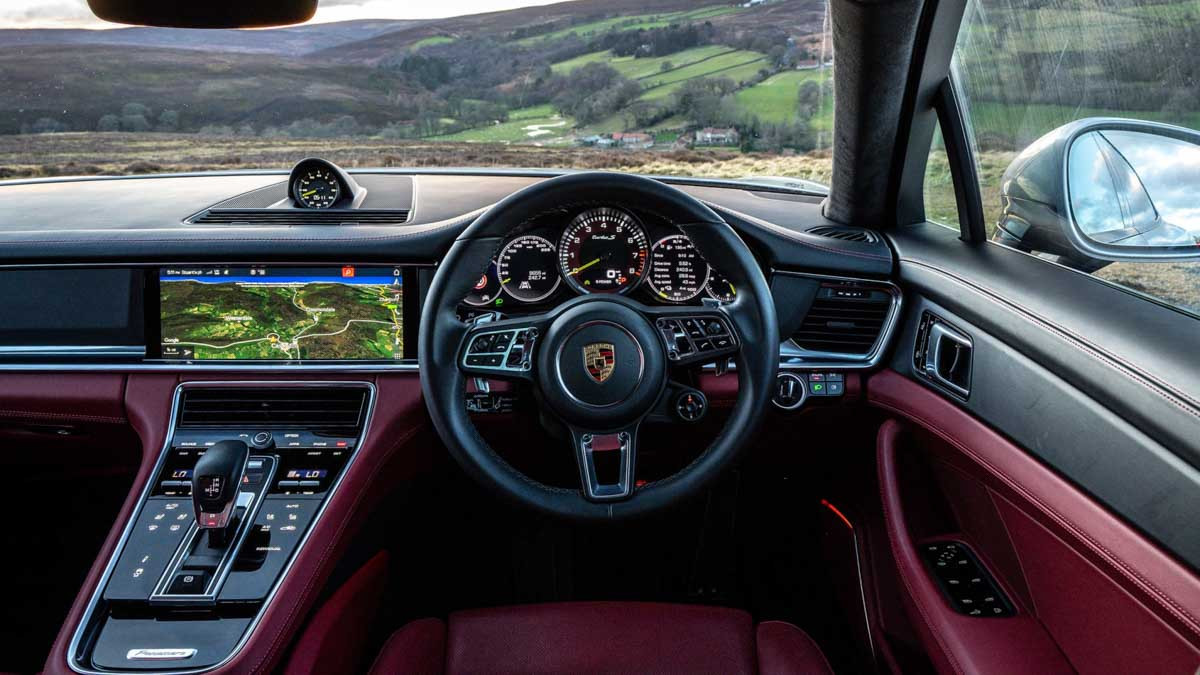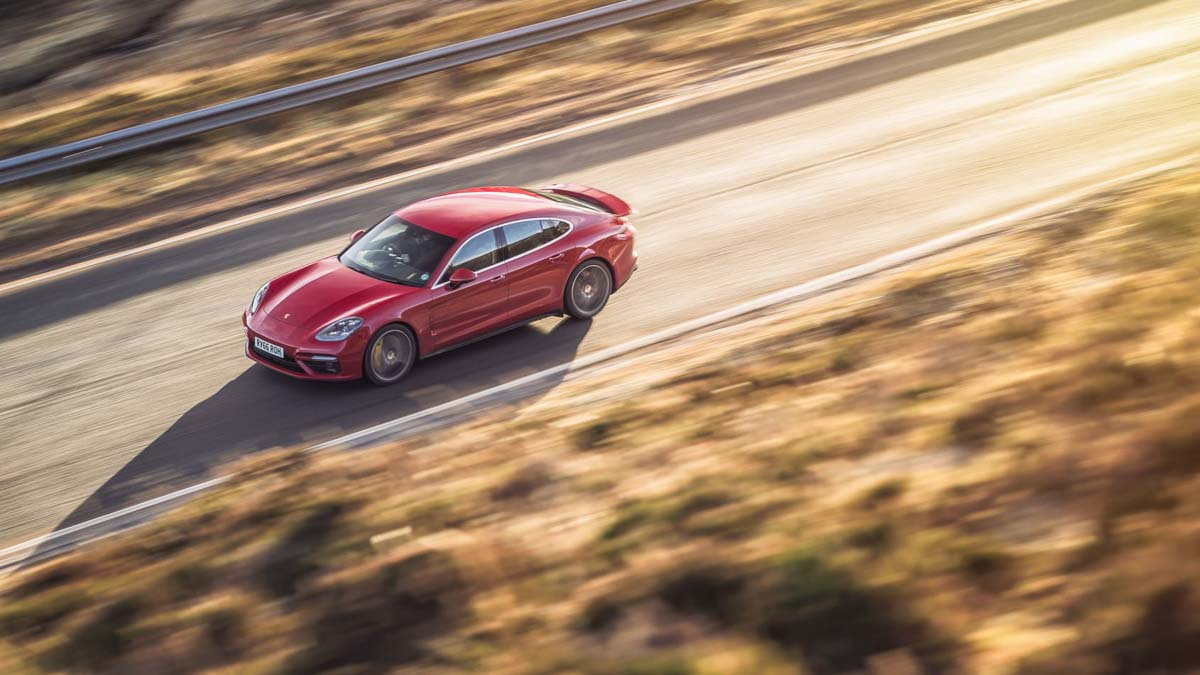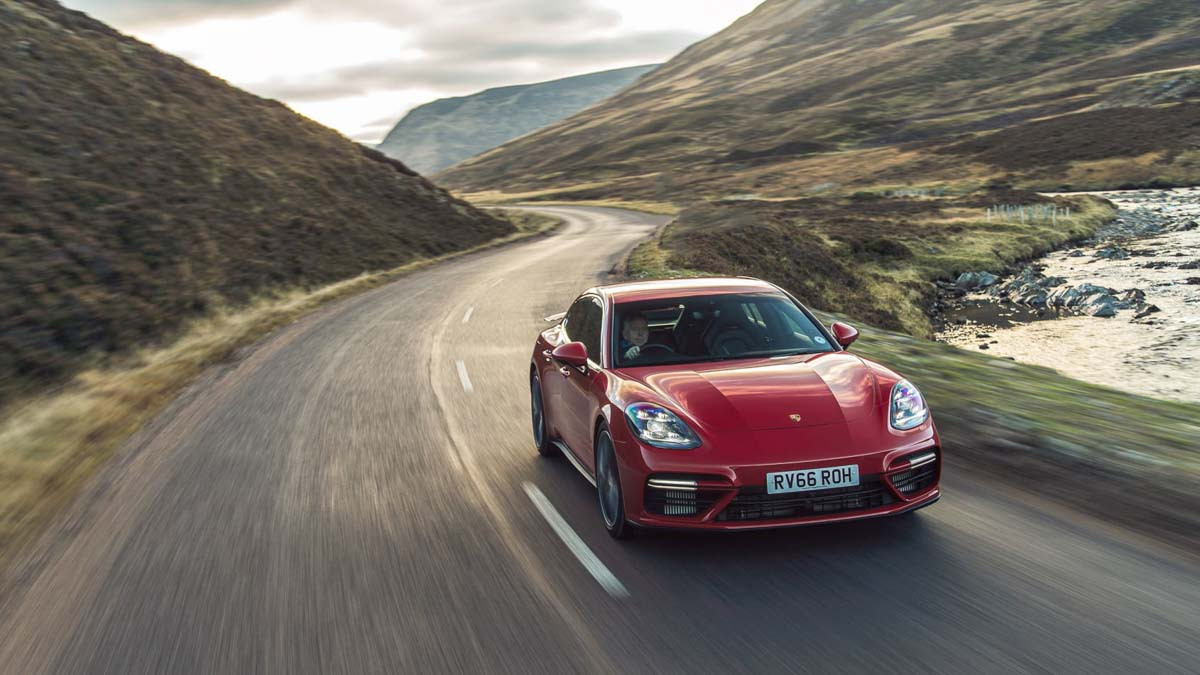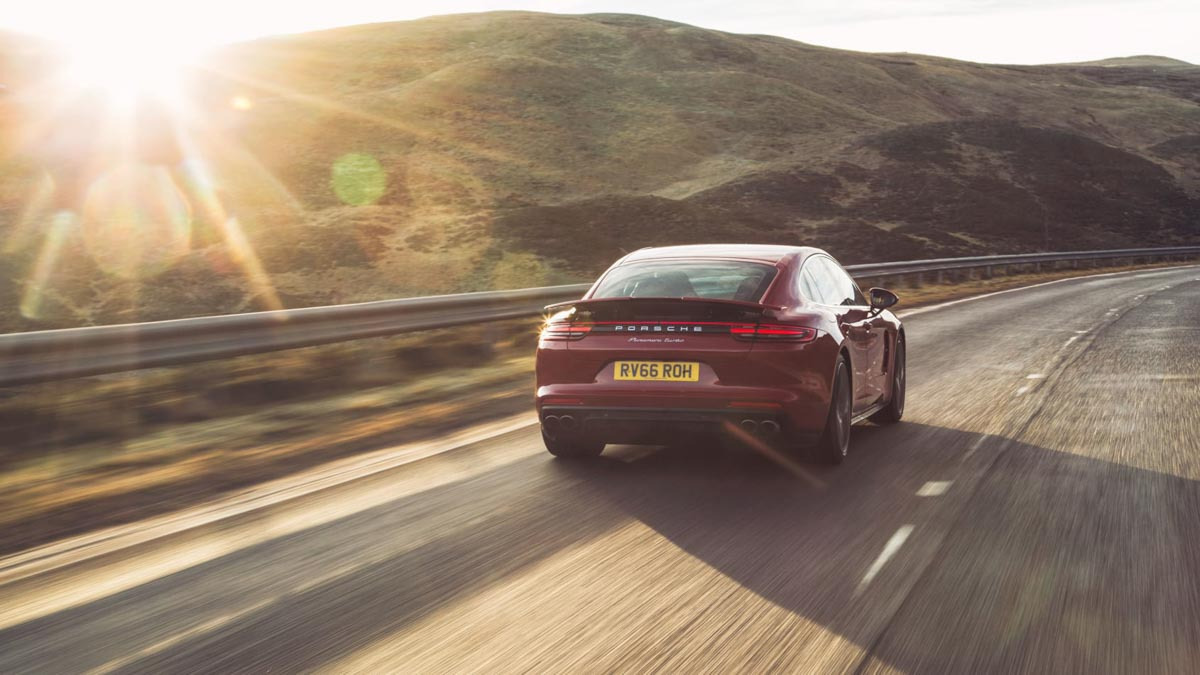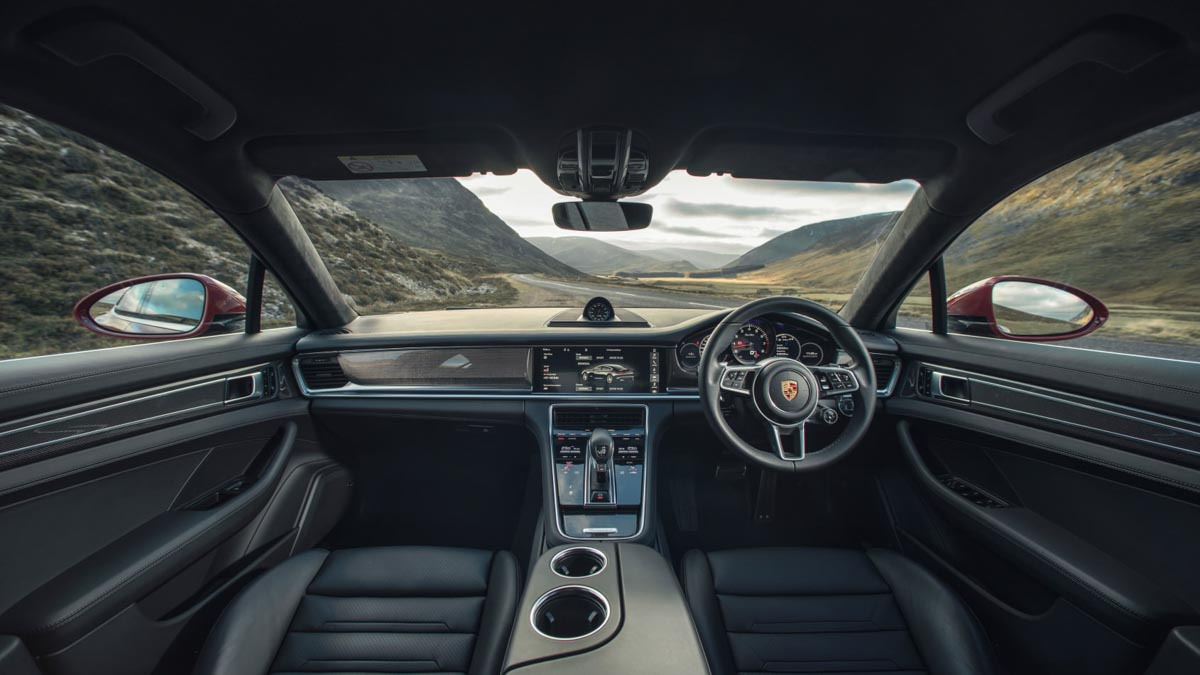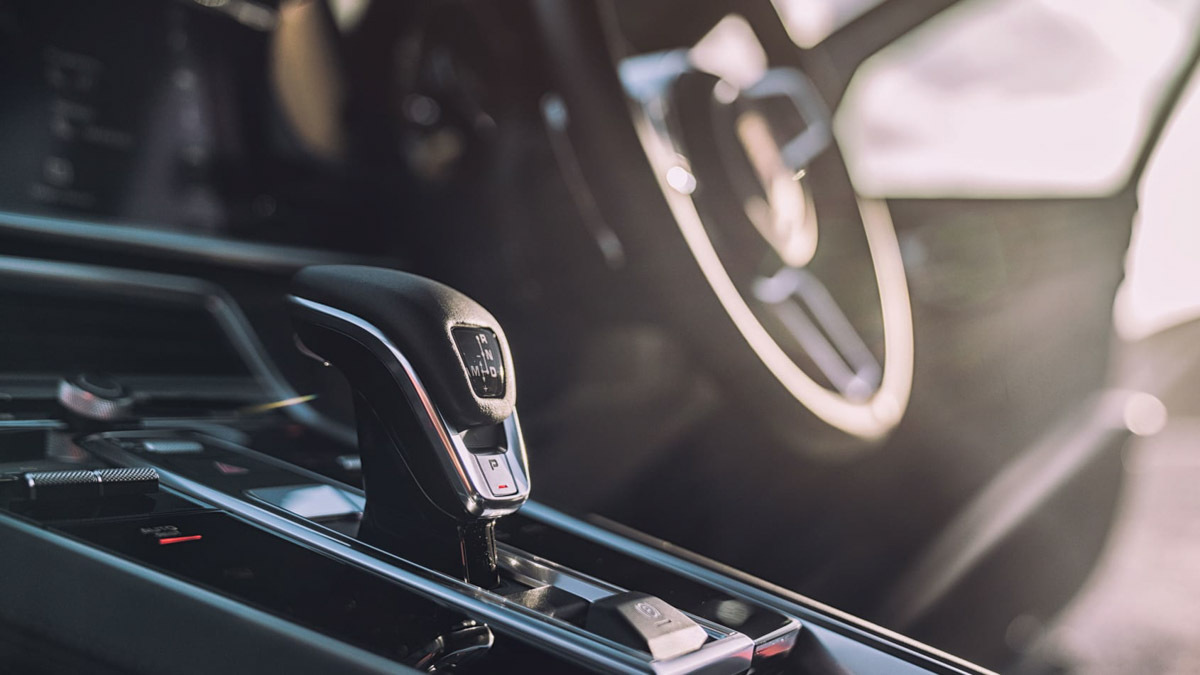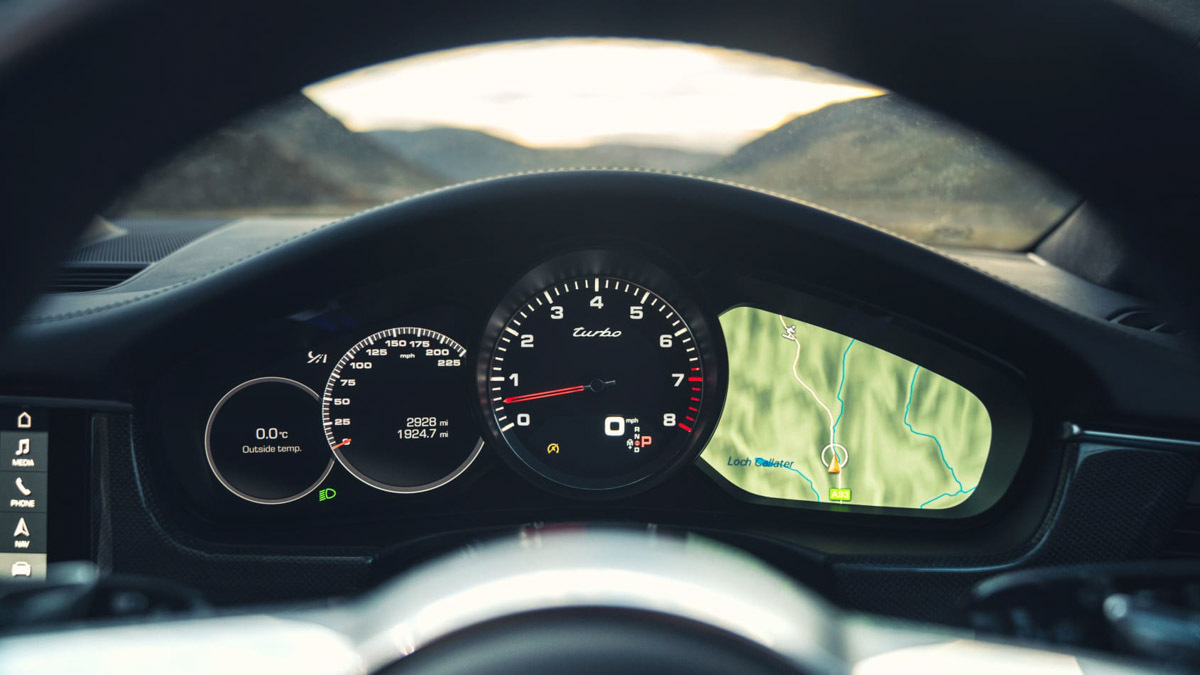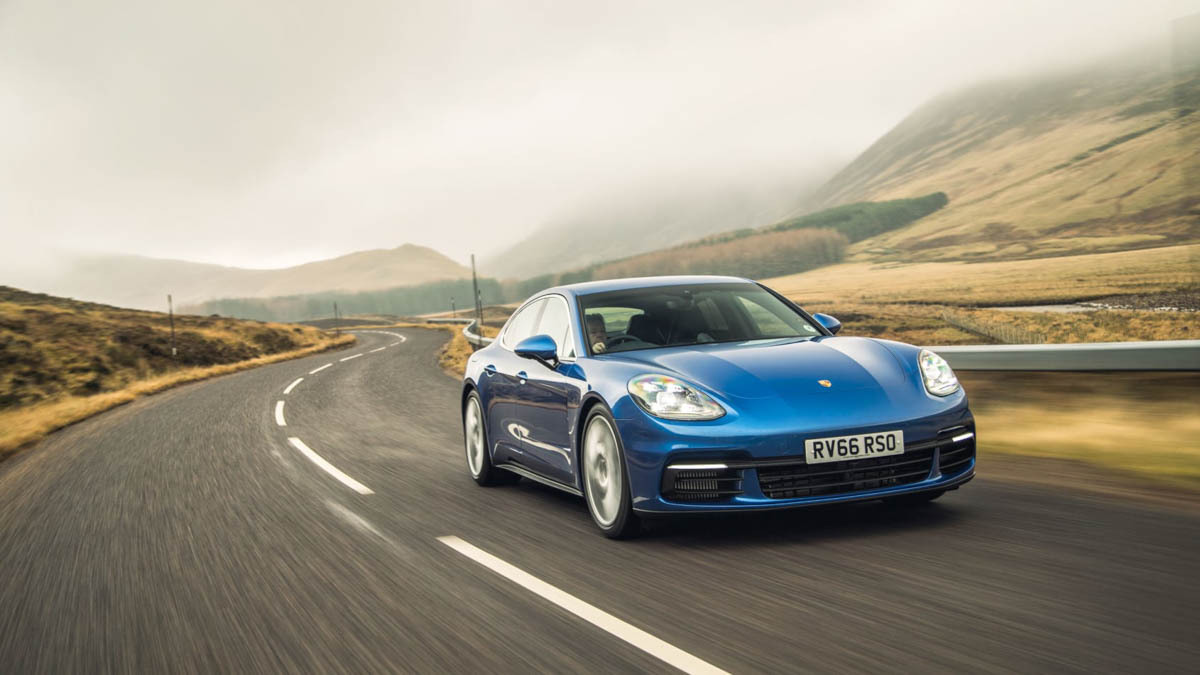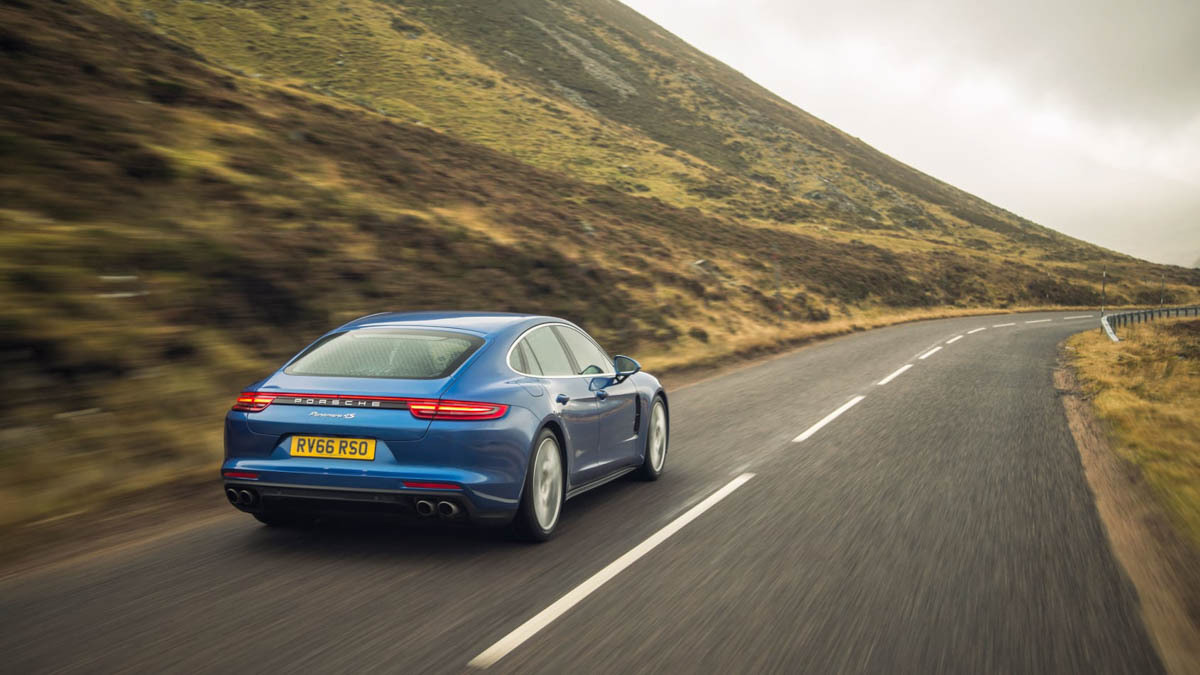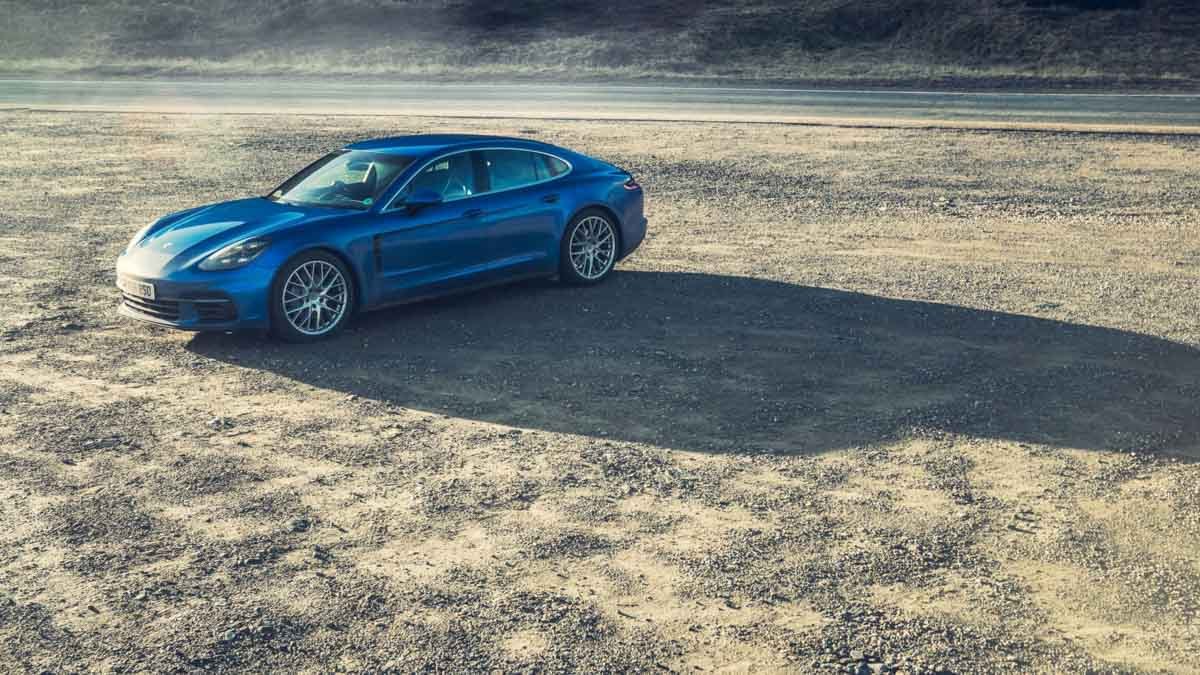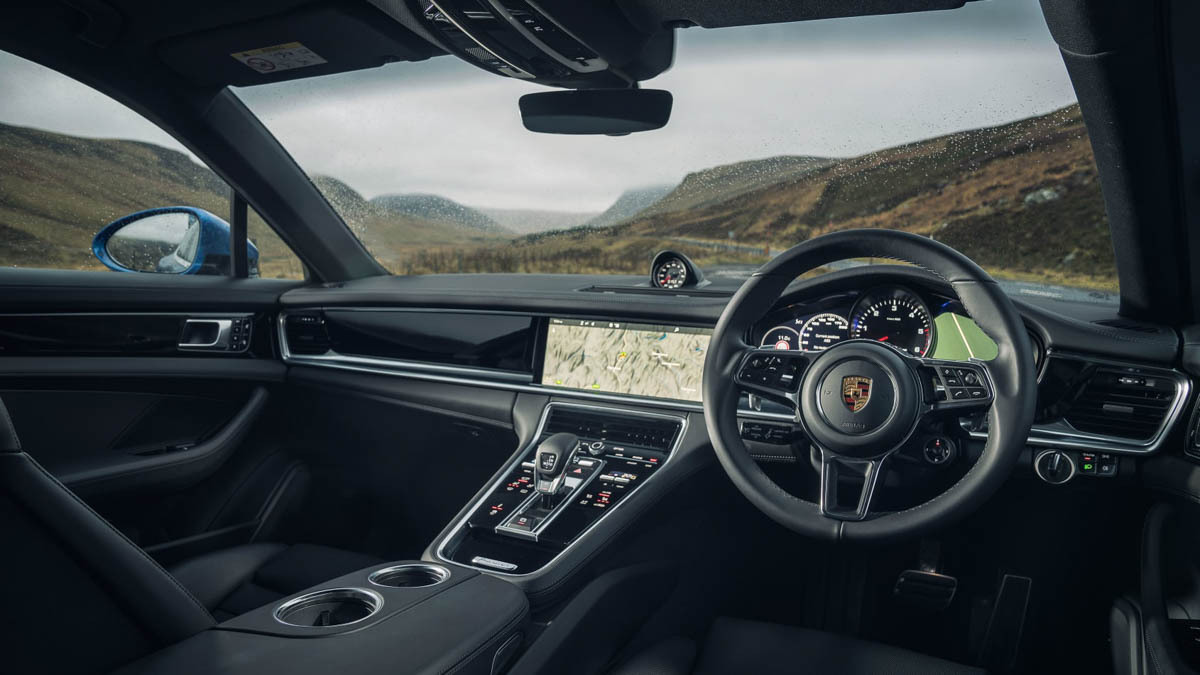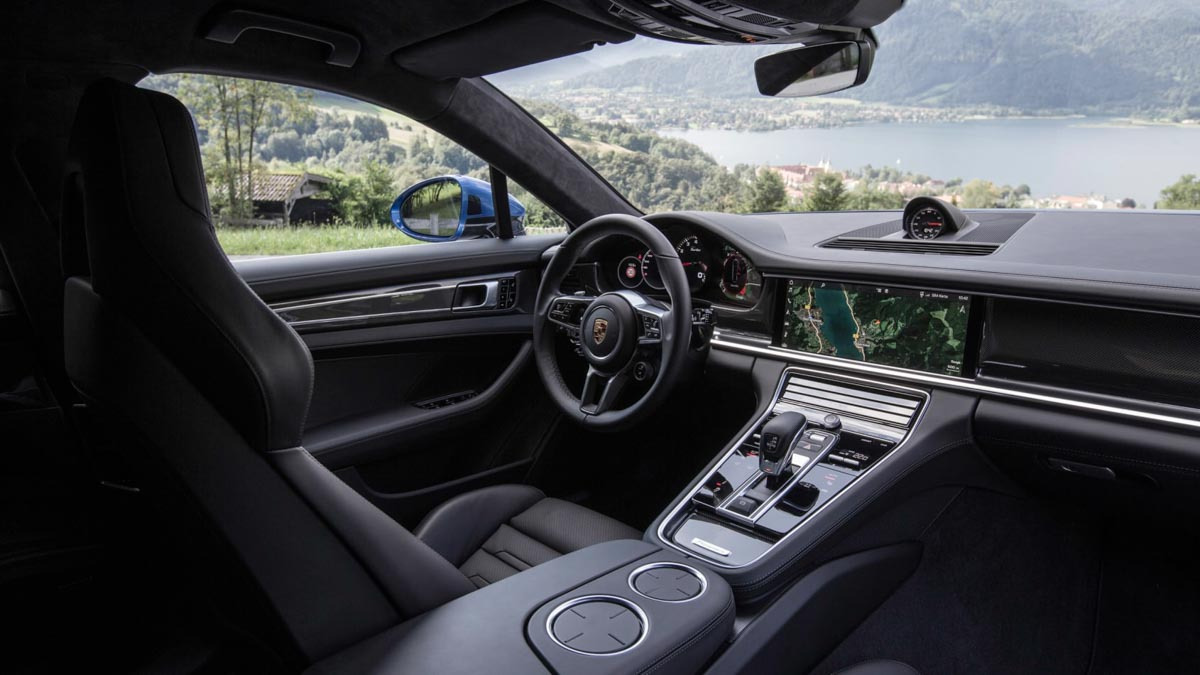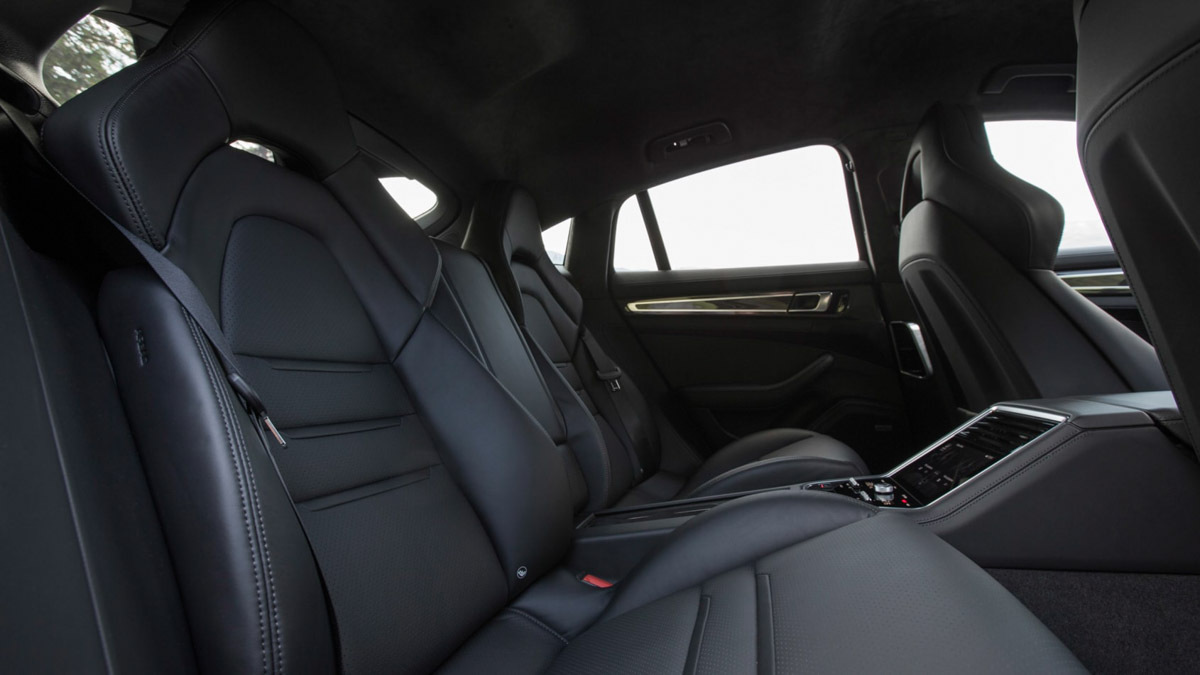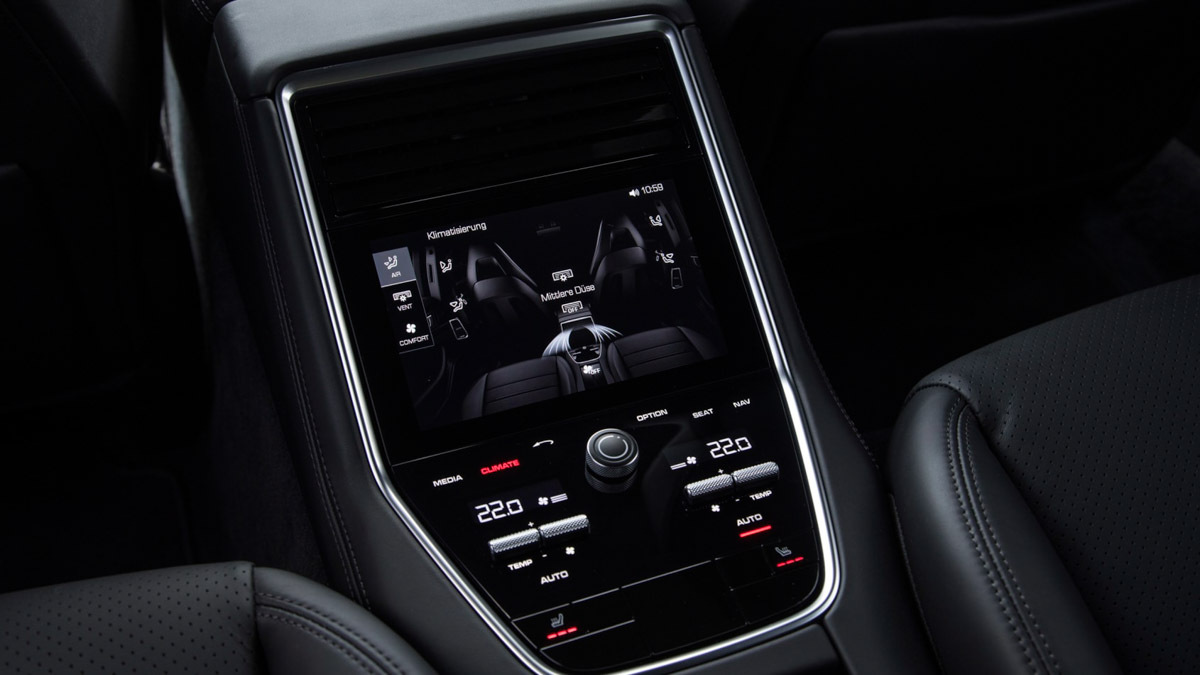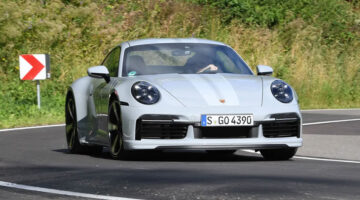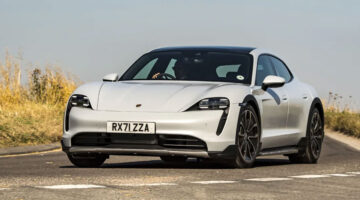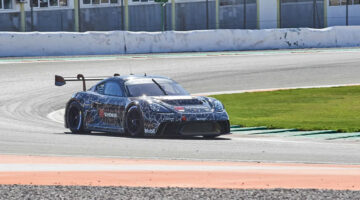A fast, sophisticated and capable flagship that entertains when the road gets challenging, just choose your powertrain carefully
While the second-generation Porsche Panamera might not seem to have outwardly changed since its introduction in 2017, the Panamera range in 2020 is quite a different proposition to what it once was. Initially revealed with V6 and V8 petrol and V8 diesel engine options, the Panamera has since dropped the diesel (as have all of Porsche’s model lines), and proliferated with two distinct E-Hybrid models, a second Sport Turismo body shape and the new mid-level GTS.
While these new variants haven’t generally changed the Panamera’s character, they have made it an arguably more rounded and tempting proposition for those in the market for a large do-it-all luxury car that has more sporting pedigree than most. Of course, the Panamera is no longer unique amongst its rivals, with AMG’s GT63 S 4-Door siding itself as a direct rival to the Panamera, and BMW’s new 8-series Gran Coupe recently arriving on the scene.
What its rivals lack is variety, something the Panamera has with a total of six different V6 and V8 powertrain options, both with and without any hybrid assistance. All Panameras are all-wheel drive and share an eight-speed dual-clutch gearbox, and get creative with the options list and everything from adaptive air suspension and rear-wheel steering to power-torque vectoring and even an anti-roll stabilisation system can be fitted.
The aforementioned Sport Turismo is a recent addition to the range that replaces the standard Panamera’s sloping hatchback with a long-roof, estate-like body. Although boot space is unchanged on paper to that of the hatchback version, its key is greater versatility, with more space above the beltline for improved dog/bike/mother-in-law conditions.
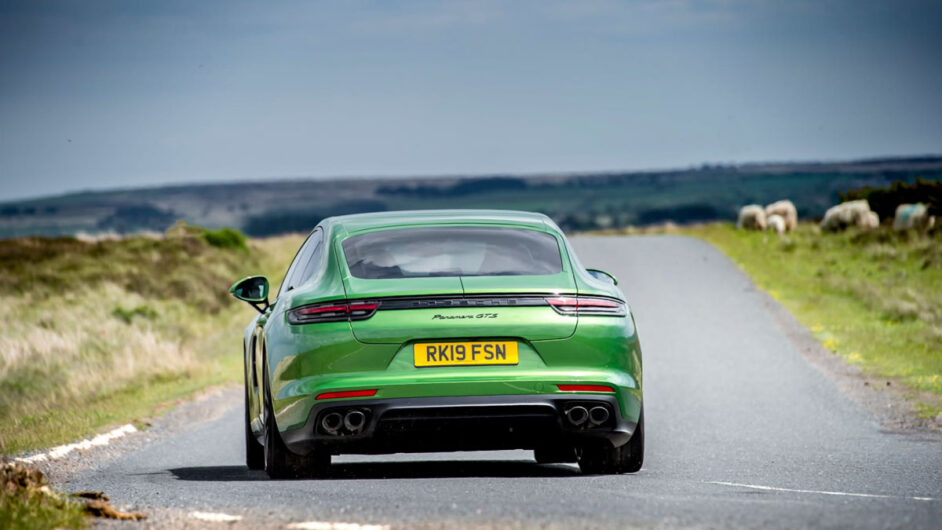
Prices, specs and rivals
All variants of Porsche Panamera are available in hatchback or Sport Turismo forms, the latter at a $2800 premium. Prices kick off at $95,150 for the basic Panamera 4, which features an Audi-sourced 3-litre turbocharged V6 engine producing 325bhp. Despite the Porsche badge, it’s actually priced just below the BMW 840i Gran Coupe ($95,950) which has a similar six-cylinder powertrain, equipment levels and accommodation inside.
Next up is the Panamera E-Hybrid, priced from $109,290, with a more potent powertrain that combines a V6 petrol engine with a hybrid drive system for a peak 456bhp output. The Panamera 4S is more money again at $120,685, and is powered by a 435bhp 2.9-litre V6.
> Read about our experience in the Porsche Panamera Turbo S E-Hybrid
Next up is the recently added Panamera GTS at $139,870, which utilises a low-powered (relatively speaking) version of the 4-litre V8 twin-turbo with 452bhp. While its power figure is dangerously close to those of the Panamera 4S and E-Hybrid, the V8 has a very different character and a suite of chassis upgrades including standard air suspension with PDCC adaptive dampers, Porsche torque vectoring (PTV) and a Sports Design package to justify its near $20k price rise over the cost of the S.
The Panamera Turbo hits harder than the GTS with its 542bhp output from its twin-turbo V8, but then also does without some of the GTS’s dynamic upgrades such as the sports suspension, Sport Design pack and Alcantara sports seats. Priced from $153,940, the Turbo rivals the more powerful 616bhp BMW M8 Competition Gran Coupe from $157,925 and the 630bhp Mercedes-AMG GT63 S at $183,470. Both the BMW and AMG are more expensive, but then also better equipped – specify a Panamera Turbo with ceramic brakes, Porsche’s active anti-roll system, rear-wheel steering, and other elements standard on the AMG and the price equalises, even if the power peak doesn’t.
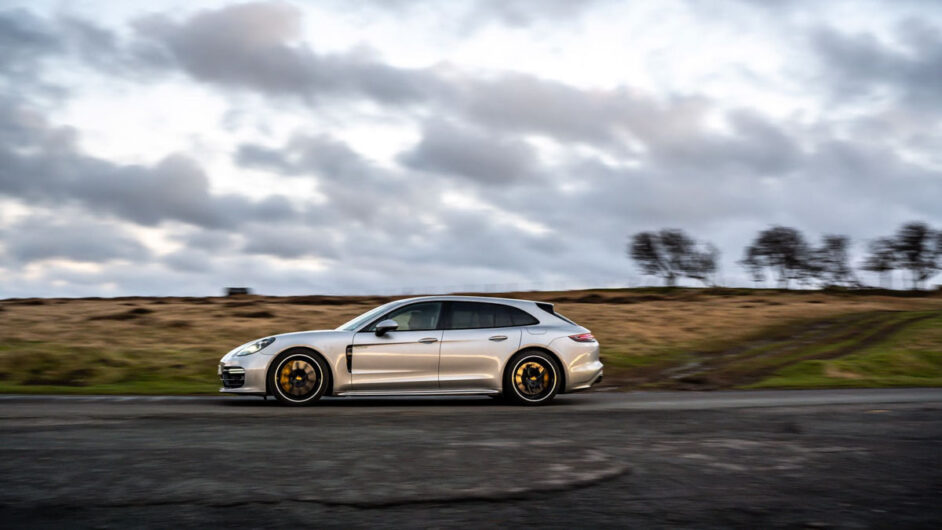
At the tip of the range is the Panamera Turbo S E-Hybrid at an AMG-matching $182,940, with an AMG-busting 671bhp peak power. While this model is fully loaded with all of the chassis tech listed above as standard (ceramic brakes, active anti-roll, rear-steer, etc) the additional 315kg the hybrid system adds to the Panamera Turbo’s 2070kg kerb weight makes it a very different performance car, and only slightly faster despite its big power advantage.
While there currently isn’t a high-performance hybrid rival for the Turbo S E-hybrid, AMG will soon change that with its own plug-in hybrid variant of the GT 4-Door, with rumours persisting of an even more powerful electrical-assistance system taking power up and over 700bhp.
All Panameras are well equipped, with standard leather trim, the full infotainment suite, 19-inch wheels and full LED lighting. Each model then builds on the standard equipment right up until the Turbo S E-Hybrid. Most of the features and chassis tech can all be cross-specified too, explaining the huge options list that can dramatically change the Panamera’s driving experience and price point. It also makes it possible to equip a basic Panamera 4 to over double its list price (we got a $95,160 Panamera 4 to $200,000 in options using Porsche’s excellent online configurator).
For less money, more mainstream supersaloons and estates from Audi, Mercedes-AMG and BMW are also clear rivals, although at $130,000 roughly for an RS6, E63 S and M5 Competition, the price variance between them is not quite as significant as it once was.
Engine, gearbox and technical specs
The entry-level Panamera 4 is fitted with a turbocharged 3-litre V6 that produces 325bhp from 5400 to 6400rpm. It also produces a torque peak of 332lb ft from 1340 to 4900rpm. This engine is also seen in A6, Q7 and Q8, pre-TDI S4 and S5 models and even the Volkswagen Touareg. Although not an inherently bad unit, far from it in fact, it remains the most humdrum engine in the range. Still, it’s propensity to rev, refined manners and fat torque curve make for a good pairing with the Panamera 4’s more laid-back demeanour.
Despite having a smaller capacity – just 2.9 litres – the V6 in both the 4S and 4 E-Hybrid produces more power and torque than in the basic Panamera. That’s because the 4S’s engine is newer and more sophisticated and features two turbochargers mounted within the banks of the two cylinders to create a hot-V engine, making for a peak power of 434bhp from 5650 to 6600rpm and 406lb ft of torque between 1750 and 5500rpm. In the 4 E-Hybrid the hot-V V6, when supplemented by a 100kW electric motor, makes an equivalent total of 456bhp and 516lb ft of torque.
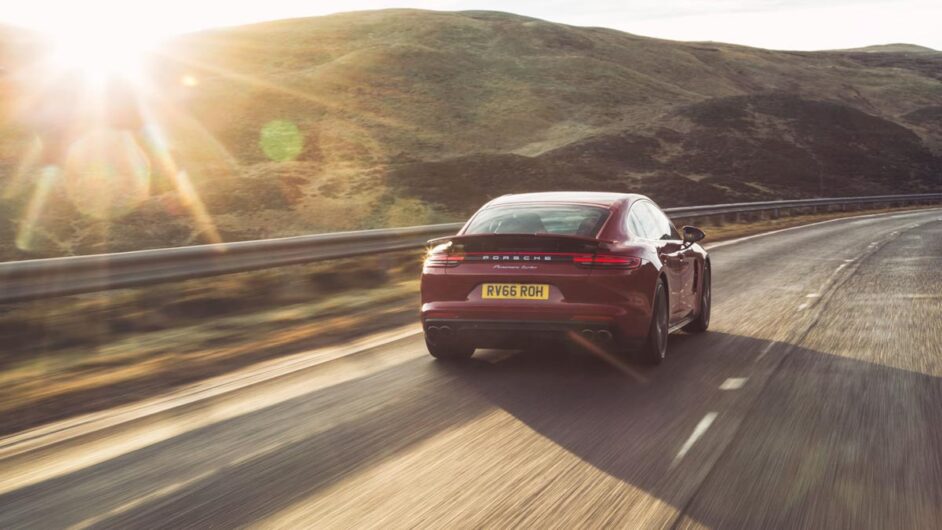
The Panamera GTS differs from typical Porsche GTS models by its use of a detuned version of the flagship Turbo engine rather than sharing a lesser S-model powertrain. This has been done to comply more easily with emissions regulations in a larger, yet less-stressed engine application, but it also gives us access to something rather wonderful. Without the neck-snapping acceleration of the Turbo, it gives you more time to enjoy the aural pleasures of its V8 engine without constantly breaking the national speed limit. The specific V8 in use is the usual 4-litre hot-V twin-turbo unit found across the Volkswagen group, but here pegged to 452bhp, with 457lb ft of torque available between 1800 and 4500rpm. Despite being close to 150bhp shy of the peak found in other applications of this engine, it remains an impressive unit.
The Turbo and Turbo S E-Hybrid share this same V8 engine, both packing considerably more power, as you’d expect. Turbo models are rated at 542bhp, with a fat 568lb ft of torque available all the way down at 2000rpm. The Turbo S E-Hybrid uses the same V8 rating as the Turbo, but bundles it with a 100kW electric motor to push those figures up to 671bhp and 627lb ft of torque.
Every Panamera, from the 4 to the Turbo S E-Hybrid, uses an eight-speed dual-clutch transmission that’s also fitted to the Bentley Continental GT. Changes are fast without being jerky, and in full-auto mode it can be a little clunky at low speeds, but it’s smooth when out of town or on a motorway.
Performance and 0-100 time
Appropriately, there’s no such thing as a slow Panamera. Even the most basic Panamera 4 makes it to 100kph in 5.3sec with the optional Sport Chrono package fitted, which includes a launch control system. Torque from this standard 3-litre V6 is strong too, so on the road it never feels lardy or strained, even if it lacks any real flare.
Panamera S models have the more rawcus 2.9-litre V6 engine that’s also shared with the Audi RS4 and RS5. While power is down slightly, performance is still strong, reaching 100kph in 4.2sec (again with Sport Chrono fitted), which is only 0.1sec behind the V8-powered GTS. The difference between the S and GTS is more prevalent in torque, where the two have a more substantial 52lb ft gap in the GTS’s favour.
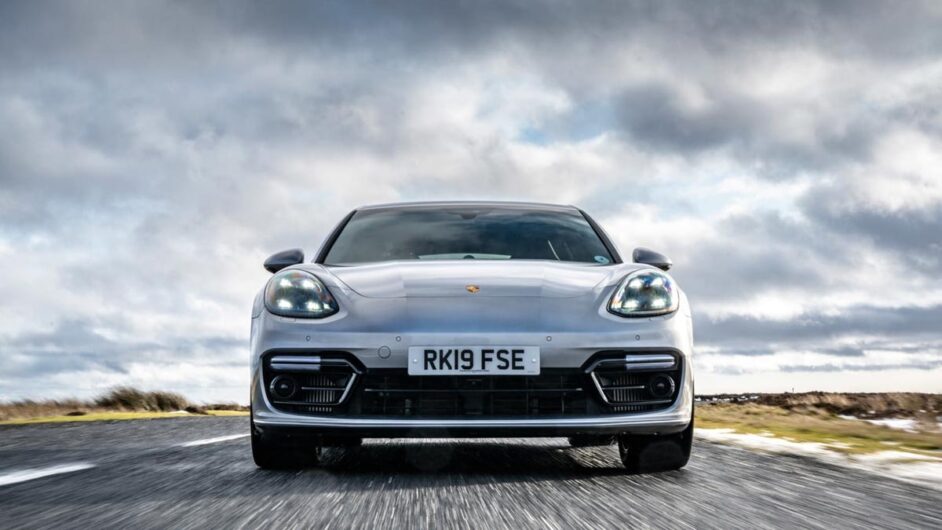
The Turbo breaks the four-second barrier with a 0-100kph time of 3.6sec, but on paper the Turbo S E-Hybrid is the quickest overall, reaching 100kph in just 3.4sec. Like the 4 E-Hybrid, the Turbo S comes with launch control as standard, and relies on its electric motors to aid that acceleration advantage despite the hybrid’s extra mass.
Unlike many German saloon cars, the Panamera is not limited to 250kph. Instead the maximum top speed ranges from 260kph for the 4, to 310kph for the Turbo S E-Hybrid. Surprisingly, despite an approximate 30kg weight increase, the Sport Turismo models are no slower to 100kph than conventional Panameras with the same drivetrain.
Ride and handling
The Panamera is an undeniably impressive machine. Yes, it’s got the sports car-rivalling performance, but it’s not just fast: Porsche’s big saloon is also enjoyable to drive. The seating position is low and there’s enough movement from the adjustable steering column to move the wheel to exactly where you want it.
It doesn’t ride like a luxurious barge, instead there’s a tension to the way it deals with a road. However, it’s far from uncomfortable, the strong structure not allowing any nasty creaks, rattles or shudders.
The taut ride doesn’t try to disguise the Panamera’s size or weight: considering its enormity that would be practically impossible. Instead, the Porsche manages its weight exceptionally well with great body control, and that endows it with an intent rarely seen in a car of this sort. Its steering is heavy, especially around town, and so is the weight of the throttle. Such substantial controls emphasise that the Panamera isn’t some effortless city car, but as they’re easy to adapt to, they’re far from a hindrance. This solid feel, combined with its well-appointed cabin and high-speed performance, means the Panamera does a great job of being a comfortable GT car.
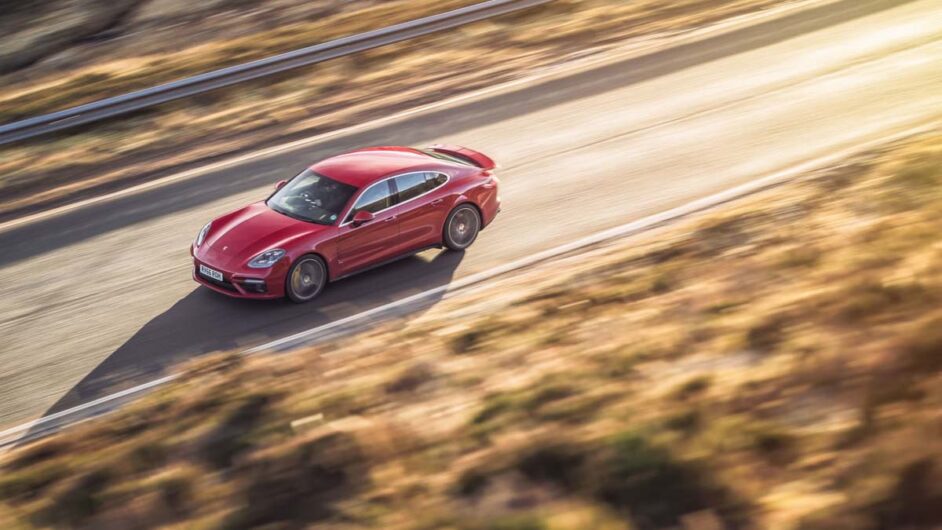
The steering rack, meanwhile, is quick and precise. There’s a significant amount of front grip too, and you can direct the Panamera with remarkable accuracy. You do feel the car’s bulk when trying to slow it down, but the brakes are more than up to the task on the road. Such a reliable front end allows you to carry huge speed into a corner, so the full force of the brakes isn’t called upon quite as often as you might think.
Once turned in neatly, the Panamera gives you the confidence to jump on the power early and balance the car with the throttle through to the exit. The 4 E-Hybrid is eager, even from low down in the rev range. However, a lot of the time its V6 sounds bland and then thrashy as the revs increase. Its built-in regenerative braking system gives the brake pedal an extremely odd feel; it shuffles up and down beneath your foot as the system juggles between conventional brakes and the regen. Blending those two methods of braking seamlessly is a fiendishly difficult thing to do and, as it stands, Porsche is yet to master that art with this car.
The Turbo is the one that feels most like a Porsche. It’s a truly fast car. Its V8 emits a menacing grumble and pushes the Panamera along at a startling rate. It responds instantly to throttle inputs and there’s real force right up until its 7000rpm limit.
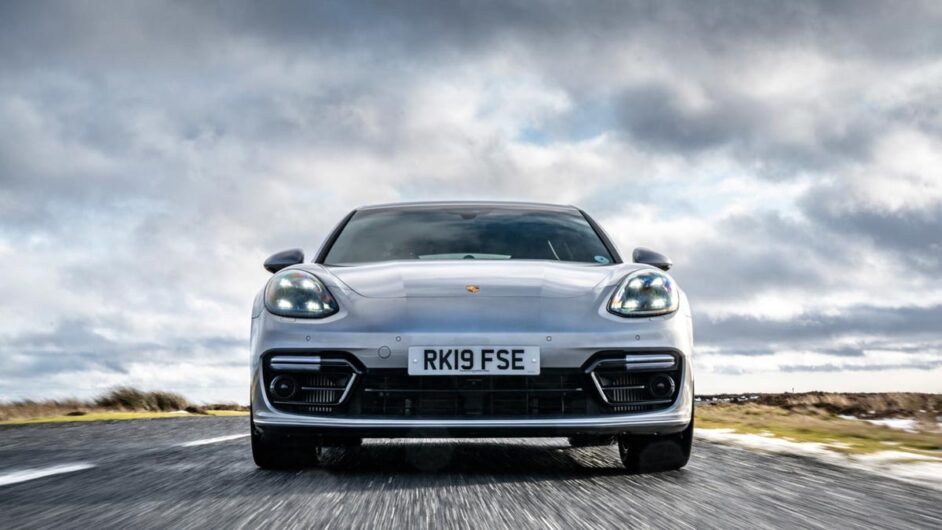
Its grunt also makes it more malleable in a corner, and liberal use of the throttle adds just a slight degree of attitude as the tyres lose their fight with the tarmac. Feeling the four-wheel-drive system hunt for grip, the tyres clawing away at the road, the Turbo gives the impression it’s like a less extreme, less mechanical Nissan GT-R. It’s not as raw, exciting or quite as involving as the Japanese sports coupe, but for a four-door saloon to behave in that manner is deeply impressive.
Just as the acceleration times aren’t affected by the extra weight of the Sport Turismo’s estate body, neither is its handling. The Panamera shares elements from its sports car siblings, with great weighting to its controls, a real agility, unshakable composure and masses of grip. However, it doesn’t feel like a true sports car. Instead it creates a character all of its own – one that’s less delicate but still involving and enjoyable.
L/100km and running costs
Panameras are always inherently big and heavy cars, which means even in hybrid form they use an alarming amount of premium unleaded. The numbers don’t look any more enticing under new WLTP regulations either, with all Panameras having experienced a sharp drop in claimed L/100km on the new cycle. Entry-level Panamera 4s have a (best) claimed figure of 10.5L/100km, which is a solid drop on before, but is still better than the 25.9 the Panamera S is able to muster.
The V8 GTS and Turbo models are, as one might expect, even worse off, with best case 12L/100km and 12.3L/100km ratings. Sport Turismo models have a slightly worse rating again by about 706.2L/100km, depending on the model.
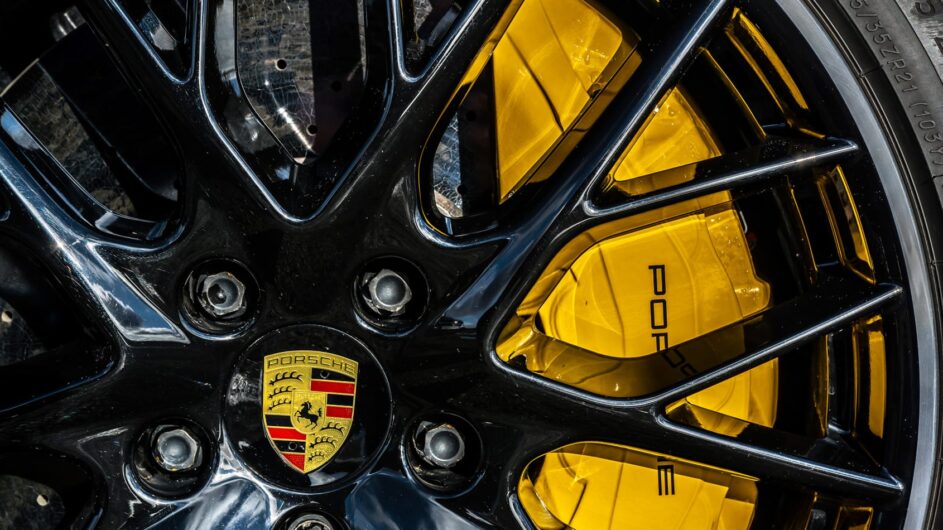
But while the new WLTP testing standard certainly doesn’t help with the standard petrol Panameras’ figures, it plays right into the hands of the two E-Hybrid models that, like all plug-in hybrids, tend to have significantly higher figures on paper than is actually achievable on the road, unless your daily commute mimics the testing procedure. So, despite having 300kg extra weight compared to the Panamera S, the E-hybrid which shares its combustion engine is rated at 3.3L/100km on the combined cycle – and the 671bhp Turbo S E-hybrid? That’s 3.5L/100km.
Drive these models for more than around 50 kilometres though and you’ll see those figures drop well into the teens, especially on the near 2.5-ton Turbo S E-Hybrid. That said, if your commute is largely town-based, and you have consistent access to charging, and keep the Panamera in its more eco-friendly modes, the hybrid systems do in fact work well to keep fuel use to a minimum. Briefly.
Aside from fuel, running costs are set to be high, even by Porsche standards. For this you can thank the outright size of the components. Wheels, tyres, brakes, oil – any consumable really that the Porsche can chew through, so it will quickly.
Interior and tech
The new Porsche Panamera’s cabin is among the best of any car, even after three years on sale. It was the first of the brand’s cars to feature a sleek, clean one-piece plastic centre console that removes the masses of buttons that litter the area near the gearlever on most modern Porsches. This design has since been spread across all Porsche’s models, except the 718 cars that are still a while away from being replaced.
The tech package is dominated by a 12.3-inch touchscreen in the middle of the dash, its predominantly black and white interface replicated on the glossy, touch-sensitive centre console. It looks sleek, modern and cohesive, but with no individual buttons to press you do find yourself deliberately peering down towards it whilst driving to ensure you are in fact cranking the heated seat up rather than switching into a firmer suspension mode.
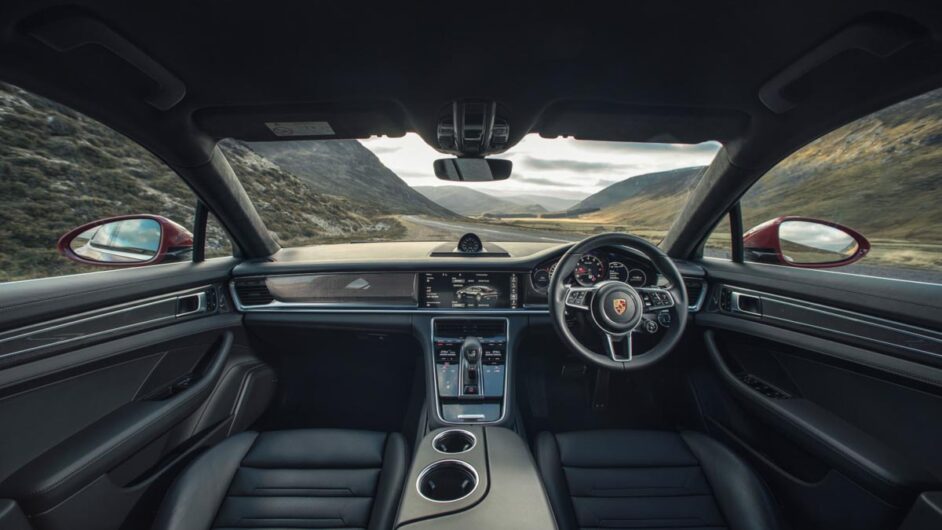
There is a satisfying clunk when you do press the entire panel – it only does this when your finger is in the correct place to operate something, so accidentally touch a ‘dead’ area and the panel doesn’t move – but with no physical edges to the button areas you could press anything without dedicating some attention to where you’re poking.
As well as looking great, the quality of the materials feels high and there’s never any sense that it hasn’t been put together with the attention to detail that you’d expect of a luxury brand. The only real downside to the Panamera’s interior is that every time you touch the shiny new panel you leave visible fingerprints on it, and that doesn’t look very neat.
Design
While the Panamera has always been popular, it hasn’t always been noted for its soundness of design. This second-generation model has a more agreeable look, not least because of its more pleasing proportions due to its MSB platform, shared at this stage with the Bentley Continental and Flying Spur. Like the interior, the second-generation Panamera also templated much of Porsche’s other models, with sleek, rounded surfaces and a full-width rear light bar.
A retractable rear wing features on all variants, but GTS and Turbo models upgrade this to a three-piece folding arrangement that is as entertaining to watch in the rear-view mirror as it is for people in the car behind.
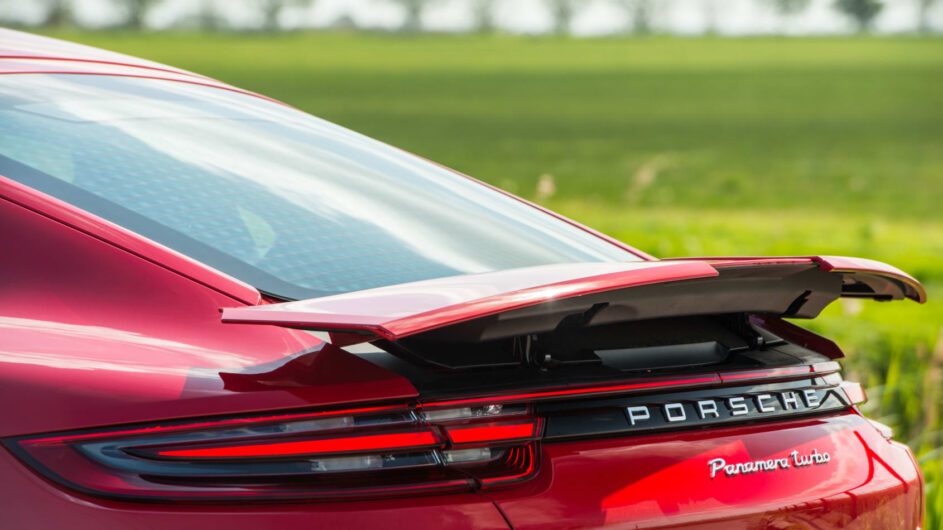
There are three basic styling variations available, with standard 4 and 4S models having a simple, understated look. Turbo models have larger front openings and the typical double-bar running lights, as well as a more assertive rear valance, but it’s the GTS with its standard Sport Design pack that has the most aggressive look with a combination of gloss black elements and tinted lights all around.
Sport Turismo models apply the same principles to a long, low estate-like body, although ironically boot space on paper is identical between the two. Turbo and GTS models also pick up a tiny active roof spoiler, making it look sort of like a demon Integrale with its little tail pointed straight up.
This article originally appeared at evo.co.uk
Copyright © evo UK, Dennis Publishing

